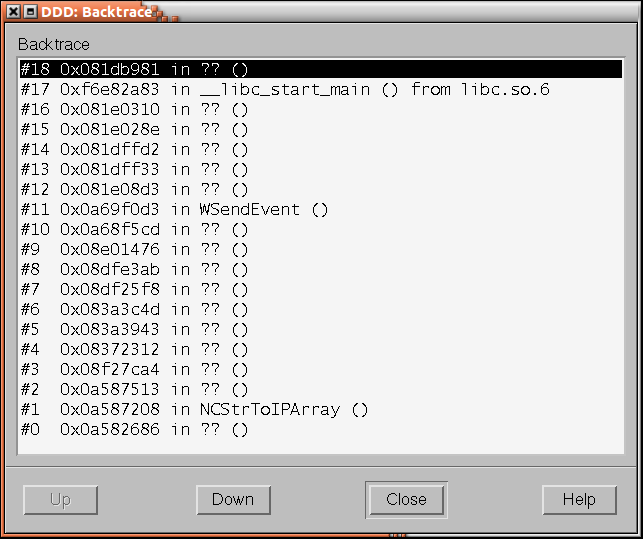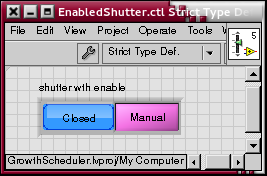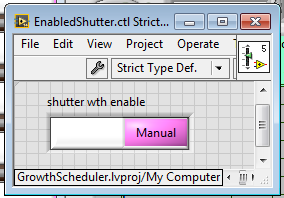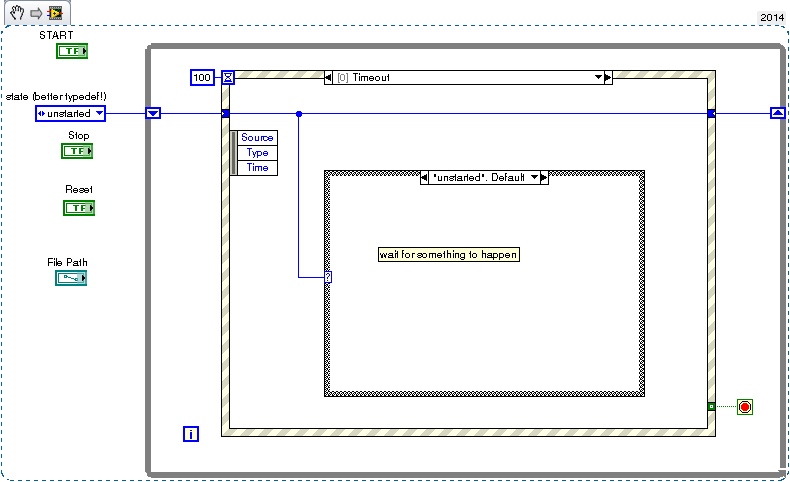-
Posts
583 -
Joined
-
Last visited
-
Days Won
26
Content Type
Profiles
Forums
Downloads
Gallery
Everything posted by ensegre
-
how badly would you roll your eyes, if I ask why wrong at runtime?
-
off topic and bear me for my ignorance, but how do you do that in LV? Plugin libraries (which I never confronted with)? Anyway, even in that situation, wouldn't it still be meaningful to ask the list of currently known children?
-
How can I, given a parent class object, get programmatically an array of names of its direct children? The information is available in the class Hierarchy view, so I thought that some secret vi buried in vi.lib/Utility/LVClass or such might have come to play, but found none. TIA, Enrico
-
This reminds me something I did years ago, perhaps in a very suboptimal way. I created a set of custom controls with funny decorations, and the user was able to drag them around on the FP and place them. The idea was to give the impression of "probes" which the user could place over a scheme of a plant. All it take was to handle mouse down events on those controls, and read coordinates as long as the mouse button was pressed, which was polled. There was even the notion of a "home" (bring back all probes in the toolbox, activate only probes which have been taken out, etc.), based on coordinate parsing. This may be a solution for translations, but it won't cover sprite rotations. If not I can think only at the hard way -- use a picture control and draw objects inside it, handle every possible mouse action with proper object redraws -- looks tedious.
-
On my laptop, I just discovered that LV2014 (but not 2011SP1 or 2013) segfaults at launch, even before the splash, if I connect to my institute via VPN, while it works and worked all the time if I'm just linked to WAN. Haven't seen that before, I wonder if it has anything to do with a latest ubuntu update. Any idea why that would happen? $ labview & [3] 7297 [1] Done labview owner@xxxxx:~/Desktop/yyyyyy$ LabVIEW caught fatal signal 14.0 - Received SIGSEGV Reason: address not mapped to object Attempt to reference address: 0x(nil) [3]+ Segmentation fault (core dumped) labview with ddd I see an uninformative backtrace: ETA: just upgraded to 14.0.1 (spring 2015) and the problem vanished....
-
I fear that this solution of covering the control to be disabled with a boolean rectangle with size dependent on state is somehow unstable, and I'm not too surprised, missing detailed size properties as mentioned above. It occurs me now that one of my compound buttons displays fine on my linux development systems, but gets mangled if I transfer the code to the test windows system, and stays mangled when I save the containing FP and bring it back to the dev sys. Attached the .ctl, this is how it looks on linux and this on windows Any experiences? EnabledShutter.ctl
-
Usually these instruments operate relays when they switch ranges, which happens for instance when you measure in some autoscale mode; or when ouputs are activated; both can be avoided for continuous measurement with a proper approach (e.g. -- determine the proper range once and repeat a fixed range measurement then). As such your question is instrument and not LV specific.
-
Right. But then one could argue, is it really important to evidence where the mouse has been clicked, or just how the resulting array differs at all? One workaround I could think (maybe), is the following: make an array of clusters, [ordinal,your_content], where "ordinal" is a flag, for example an integer which defaults to -1 and is set to the element number by the Value Change event. In the GUI you could hide "ordinal" if it falls in the way. Then finding the insertion translates into finding the first -1 in New Value, finding a deletion means finding a jump of 2.
-
What I normally do is to compare Old and New Value and look for the first nonequal element. If the new element is added at the end of the existing, off the head the boolean array will be short as the Old, but the increased length will asess the change in the last element.
-
possibly relevant? (besides perhaps just projecting the text more into the direction of the observer, out of the solid)
- 2 replies
-
- 3d picture
- add text
-
(and 1 more)
Tagged with:
-
For that, divide the continuous acquisition in chunks, say of ~100ms worth of data, and care for accumulating the data in some buffer or array as time goes on. That way an user event can be processed at the first available slot, before the acquisition completes. The completion of the 2min worth can be tracked with a counter of chunks. As said this is something you control very well if you use the elementary DAQmx blocks, I'm not really familiar with these Express VI signal thingies and I generally avoid them. I don't really understand what you mean, and I can't get into every detail of your coding. At first sight, though, perhaps you should think more in dataflow terms. For instance, your code seems to acquire only once before the event structure; the signal on the output wire is not going to change before the next iteration of the outer while loop (2min?). I don't understand therefore what should happen in the inner while loop in the Acquiring case within the Timeout event. Why do you need an inner while? And why at all a case structure in the timeout event, which redoes and interferes with the way state changes are dealt in other events? I didn't look too carefully at your code, though, nor attempted to run it.
-
Rambling on my recurring need for backsaving (e.g. quick fix of an old vi on a deveolpment machine with newer LV, deploy on some older LV), and academically thinking at whether someone had already bothered delivering a tool for mass backporting VIs/llbs/projects etc., I ran into these, for the record: Save an LLB to the Previous Version of LabVIEW Programmatically Save VIs for Previous Version list of LV versions backsaving to which other previous About this latter, I wonder if there is some property working in an arbitrary LV version, providing the list of previous versions for which backsaving is possible. Also: a typical clumsy conversion case for me is the following: two main VIs using several but partially distinct subvis from a given reuse llb, need to backsave both, I start with the first and forget that the resulting backsaved llb contains only the dependencies of the first main and not of the second one. And, anyone still remembers the catastrophic bug crashing LV when backsaving anything containing an event frame? I think it was 8.6->8.0.
-
vormessung c.vi of course.
-
This could be, schematically, one way to do that. To you to write proper code for each action, of course. I'd recommend to use true DAQmx VIs rather than these Express thingies and separate Create Task, Start Task, Read channels, Stop, etc. That way you can keep the DAQ task open across states, and repeat only the read on demand. vormessung c.vi
-
If you have already an idea of the state machine, you're already well set for a start, you have just to see one by one the programming details of the subtasks you need to implement. In general I could suggest: -look up examples and get accustomed to the basic operations (e.g. create DAQ task/acquire continuously/graph data/save data), even in a run-once example. -spot out if there are tasks which need to run concurrently in your construction, like e.g. processing or graphing data while more is being acquired, react to GUI events while processing still goes on, etc: these need separate while loops, and a way to communicate data between them (as simplest, local variables; more structured data queues, producer-consumer model,... different solutions with different merits) -learn and define which tasks need a setup which is carried on to every other state of the machine, e.g. definition of the DAQ tasks, and how to carry the information from one state to the other via shift registers. Similarly for properly closing resources on stop/change of configuration, etc. Event structures are not difficult - you just drop the frame inside the while loop and decide whether you need a timeout action or not. The easier events to be grasped are those generated by a GUI action, e.g. the user presses the save button, a Save button Value Change is generated, and the relevant code in the frame is executed for that iteration of the while loop.
-
Indeed, now that you remark, I see a couple of relevant threads there: Automatic Build System for LabVIEW What is your CI Toolchain?
- 2 replies
-
- build script
- gitlab
-
(and 1 more)
Tagged with:
-
Anyone using, are there recommendations or tips to share? Following to my whines for a serious internal SCC, I got my IT to install Gitlab CE on an internal server, and I'm happily tucking with it so far. I see that Gitlab should have a product called Gitlab CI (continuous integration) as well as the option of webhooks to external services, I wonder what else it would take to have the functionality working, with private availability of the build. E.g. which build script, where sits LV, cross-platform builds if relevant, periodicity of the build (every commit? nightly? tagged? only last?) etc. General pointers to how automated builds (specifically LV) are handled by other SCC also appreciated, for my education.
- 2 replies
-
- build script
- gitlab
-
(and 1 more)
Tagged with:
-
I'm trying this technique which is the simplest, but I'm finding really difficult to achieve correct alignment between the rectangles (in LV2014 linux). Moreover, once I drag the control on a FP, the result morphs to an unpredictable container size, with arbitrary displacement between the two rectangles - sometimes one of them not even clickable. When I edit the control appearance, depending on the mode I am into (wrench or tweezers), I note that there seems to be some sort of containing frame, appearing as dashed if I select an area around the control, which encloses the button rectangles in all of its possible states - but the relation between the two button rectangles I can resize, their relative position, the frame, and the result once used in another FP is a complete mystery to me. Are there known bugs, is perhaps the idea of different sized boolean images something which sneaked through the cracks of LV, but isn't really supported? I note that while for instance there are properties supporting the four colors and four strings for all states of the button, there are only one Button Size and Bounds. Attached my simple attempt: it would be a rectangle of about 135x35, half width when off, derived from the Classic Flat Square Button. Well, just resizing the on and off state rectangles, not dragging in anything from the decorations palette. LeftNumberCoveringBoolean.ctl
-
I would first of all look at which hardware are you going to use. A stepper motor? They usually come with controllers, and you talk to them for instance with simple VISA commands. A DC motor with a set of range microswitches to understand the floor at which the elevator is, whether to open doors, etc? Then you'd need a current driver for the motor and some digital ins for the switches. Something else? DAQ, is there something analogic? Arduino: do you need software to run embedded on it, or can you leave all tasks to the host, so that the arduino would just be a DAQ alternative? On top of that VI logic. Transfer function? In the terminology I'm familiar with that has to do with the frequency response of a linear system; for an elevator?
- 1 reply
-
- elevator
- elevator through labview
-
(and 1 more)
Tagged with:
-
All interesting ideas, hats off! Can't really mark four or five posts as the Solution, do I?
-
How can you make a boolean with size depending on its value?
-
yeah, that gives a better experience. The price perhaps is that the focus condition has to be continuously polled in the timeout case, but its impact should be negligible. EDIT: I see that it works because the editable value read is exactly that of the current element of the array, i.e. that containing the string which has currently focus. I would not have thought at once. I'm afraid that, besides requiring the position to be continuously polled, it will identify the element only as long the mouse is on it. Or, at least as long as it is detected that focus entered to the string (following a mouse click). But tabbing, etc... In any event, thanks everybody so far for the suggestions.
-
thanks, but that is what I meant by Extending, I could also think ahead at pseudo-disabling mouse-operated controls, like booleans or menu rings; for them indeed trapping the mouse down (and working out the coordinates) should be doable.
-
Cool, I need to study it. As you say, it may be that the infrastructure needed overwhelms the benefits in my use case.
-
Right, that is an idea. But how to identify the array element? Key down doesn't return coordinates which can be worked out, and Array, unlike table, doesn't have a property which returns EditPosition.







